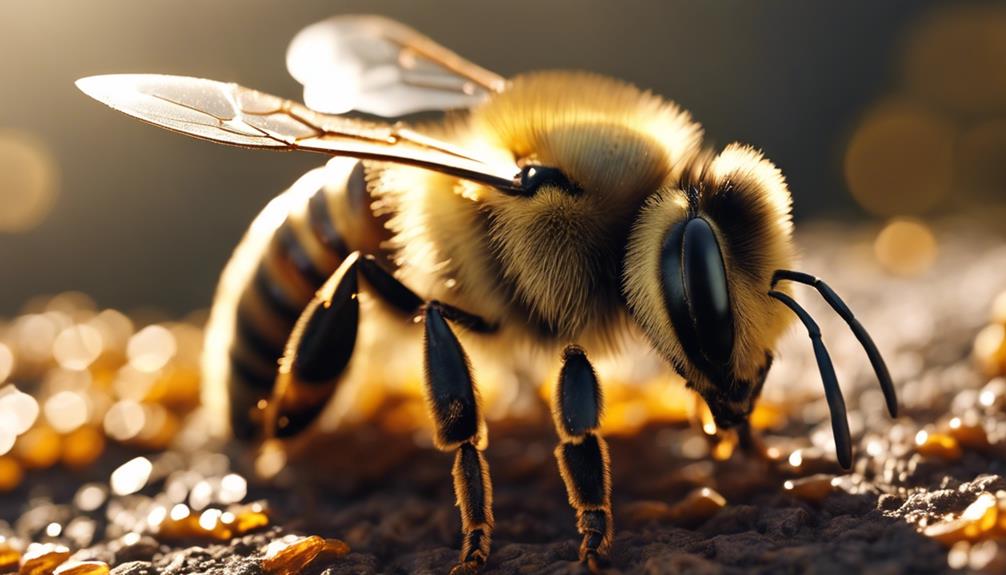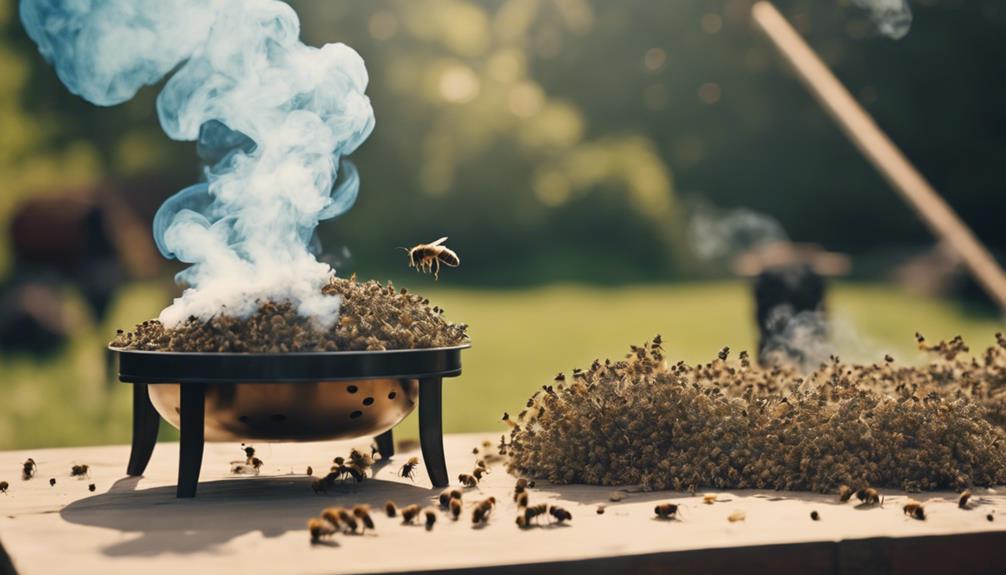When a worker bee stings you, it injects venom containing proteins like melittin, causing immediate pain and inflammation. The bee’s stinger, equipped with barbs, gets stuck in your skin, leading to the bee’s sacrifice as it dies from abdominal rupture. Even after the bee’s heroic act, its detached stinger continues to pump venom. Stick around to discover more about the intricate world of bee stings and their consequences.
Main Points
- Worker bees sting to protect the hive, sacrificing themselves due to their barbed stinger getting stuck.
- The stinger causes fatal abdominal rupture in female bees, leading to their death.
- Bee venom contains proteins like melittin, phospholipase A2, and histamine causing pain, swelling, and allergic reactions.
- Immediate effects of a bee sting include pain, swelling, and itching due to the venom’s components.
- Treatment involves removing the stinger, washing the area, applying cold compress, and seeking medical attention for severe reactions.
The Mechanism of Bee Stinging
Often, a worker bee stings by piercing the skin with its barbed stinger. This barbed stinger is like a one-time ticket for the bee because, unfortunately, bees die after stinging. When the bee plunges its stinger into the skin, it gets stuck due to the barbs. As the bee tries to fly away, the stinger, along with part of its abdomen, is ripped out, causing the bee’s ultimate sacrifice.
This may seem extreme, but for bees, stinging is a protective mechanism for the hive. It’s their way of saying, ‘Back off, we’ve a colony to defend!’ So next time you see a bee buzzing around, remember, they’re just trying to protect their home sweet hive.
Why Bees Die After Stinging
After stinging a mammal, female worker bees die due to their barbed stingers becoming lodged in the thick skin, ultimately leading to their demise. When a bee stings, its stinger, which is connected to the digestive tract, muscles, and nerves, gets forcefully ripped out of its body. This results in a fatal abdominal rupture, fundamentally causing the bee to bleed out as it lacks blood to sustain life.
The detached stinger continues to pump venom into the victim, even after the bee’s death. Within minutes, the bee succumbs to the injuries and venom injection, sealing its fate. It’s a sacrifice bees make to protect their hive, a fascinating yet sobering aspect of these industrious worker bees.
Understanding Bee Venom
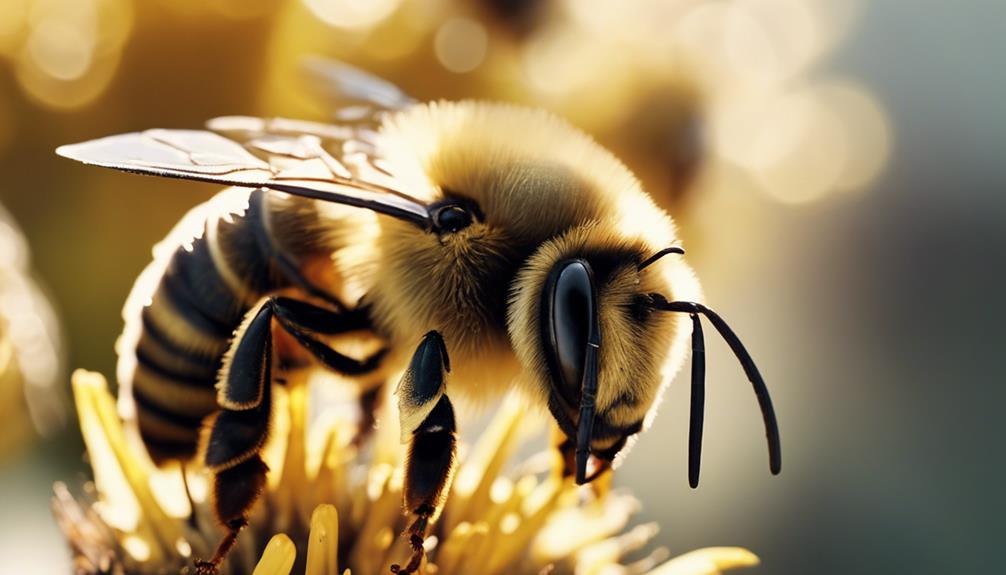
So, let’s talk bee venom. Did you know it’s not just a single substance but a cocktail of proteins, peptides, and enzymes?
This mix is what causes the pain, swelling, and sometimes even allergic reactions when a bee stings you. Understanding the components of bee venom can help us grasp why our bodies react the way they do and how treatments like apitherapy may harness its healing properties.
Bee Venom Composition
Comprehending bee venom involves acknowledging the various compounds found within its composition, such as melittin, phospholipase A2, and histamine. Here are some key points to help you understand bee venom better:
- Melittin is like the ‘bad cop’ in bee venom, causing pain and inflammation at the sting site.
- Phospholipase A2, on the other hand, can trigger allergic reactions and even lead to tissue damage – not the kind of guest we want at our body’s party!
- Histamine plays the role of the ‘alarm bell’, setting off itching, redness, and swelling as part of the immune response.
Bee venom composition can vary slightly between bee species, influencing how our bodies react to it.
Allergic Reactions Risk
When considering the risk of allergic reactions to bee stings, understanding the components of bee venom becomes vital. Bee venom contains melittin, which causes the pain we feel when stung. Allergic reactions to bee stings can vary from mild swelling to severe respiratory issues or even anaphylaxis. Histamines in bee venom contribute to swelling at the sting site. For individuals with allergies, severe reactions can be life-threatening. Recognizing and managing these reactions is essential.
Bee Sting Treatment
Bee venom, a complex mixture of enzymes, peptides, and proteins, plays an important role in causing pain and inflammation when a bee stings.
Here are some tips for treating a bee sting:
- Remove the Stinger: Make sure to scrape off the stinger with a blunt object to prevent more venom from entering the skin.
- Wash the Area: Clean the affected area with soap and water to reduce the risk of infection.
- Apply Cold Compress: Use a cold compress or ice pack to help with pain and swelling.
- Use Antihistamines: Taking antihistamines can help alleviate itching and redness caused by the sting.
- Seek Medical Attention: If you experience severe allergic reactions or have been stung multiple times, seek medical help immediately.
Allergic Reactions to Bee Stings
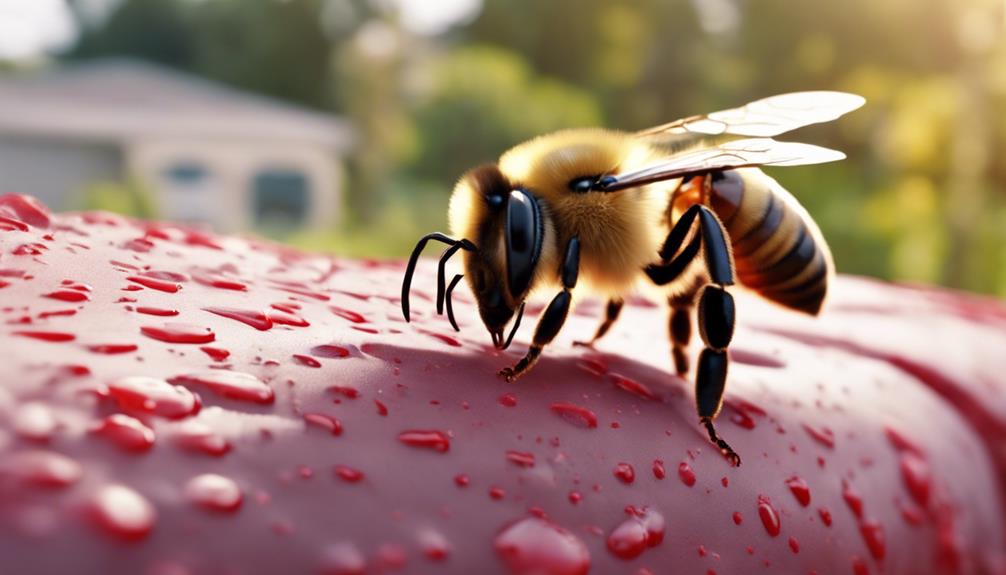
Allergic reactions to bee stings can be serious, ranging from mild discomfort to life-threatening anaphylaxis. Symptoms may include difficulty breathing, dizziness, and a sudden drop in blood pressure.
It’s essential to seek immediate medical help if experiencing severe reactions to bee stings.
Severe Allergic Bee Stings
Experiencing severe allergic reactions to bee stings can quickly escalate into a life-threatening situation known as anaphylaxis. When faced with severe allergic symptoms from a bee sting, it’s essential to act swiftly and seek immediate medical help. Here are some vital points to remember:
- Symptoms of severe allergic reactions include difficulty breathing, swelling of the face or throat, and a rapid drop in blood pressure.
- Anaphylaxis from bee stings is rare but can be fatal if not treated promptly with epinephrine.
- Allergic individuals should carry an epinephrine auto-injector for immediate self-administration in case of a severe bee sting reaction.
- Seeking immediate medical attention is crucial for anyone experiencing severe allergic symptoms after a bee sting.
Anaphylaxis Risk Factors
When faced with severe allergic reactions to bee stings, it’s important to take into account the risk factors for anaphylaxis, a potentially life-threatening allergic response. Certain individuals, like those who’ve experienced previous allergic reactions or have asthma, are at higher risk.
If you find yourself allergic to insect venom, the chances of developing anaphylaxis from honeybee stings increase. It’s like the venom sac is a tiny troublemaker for some of us!
Symptoms such as difficulty breathing, swelling, hives, and a drop in blood pressure are red flags that need immediate attention. Remember, quick medical help is essential in treating anaphylaxis resulting from bee stings. Stay informed and stay safe!
Emergency Treatment Options
Seek immediate medical attention if you experience severe allergic reactions to bee stings. When faced with a life-threatening situation like anaphylaxis, quick action is essential.
Here are some emergency treatment options to contemplate:
- Use an epinephrine auto-injector: This device can help counteract the severe symptoms of an allergic reaction.
- Call emergency services: Don’t hesitate to seek professional medical assistance in case of a severe reaction.
- Avoid further stings: Move away from the area to prevent additional bee stings.
- Monitor breathing and heart rate: Keep an eye on critical signs and seek help if they worsen.
- Stay calm: Panic can exacerbate the situation, so try to remain composed while waiting for medical help.
Bee Sting First Aid
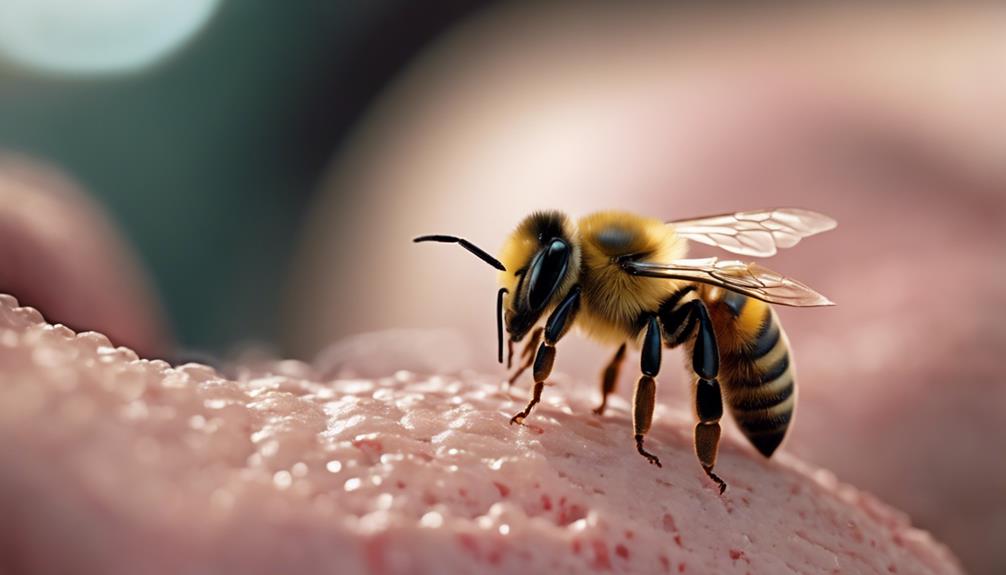
Promptly removing the bee stinger limits venom injection into the body, an essential step in bee sting first aid.
After getting stung by one of those honeybees, wash the affected area with soap and water to ward off any potential infections.
If you’re feeling the sting, applying some ice can help with the pain and reduce swelling.
And hey, if the itchiness starts bothering you, whip up a baking soda paste or try other remedies to soothe it.
Remember, if the sting is in a sensitive spot or if you notice any allergic reactions, don’t hesitate to seek medical help.
Taking care of those stings with these simple steps can make the whole experience a bit more bearable.
Long-term Effects of Bee Stings
Experiencing a bee sting can lead to rare but potential long-term effects that may include localized pain and swelling lasting for a few days. When it pertains to bee stings, it’s essential to be aware of possible lasting impacts. Here are some facts to ponder:
- Some individuals may develop increased sensitivity to bee stings over time, leading to mild allergic reactions.
- Chronic symptoms like persistent itching or redness at the sting site can linger for weeks post-sting.
- Rarely, scarring or skin discoloration might occur, especially if stung multiple times in the same area.
- Seeking medical attention for severe or prolonged reactions is crucial to prevent long-term complications.
- Remember, whether it’s from female honeybees, hornets, or wasps, being cautious and prepared can help mitigate the risks associated with bee stings.

Hello! My name is Noel Calvin. I graduated from UCLA and now work as a writer at Launch Ninjas. I write blog posts that inspire and guide our readers in their entrepreneurial pursuits. I live in Pleasantville, NJ, with a peaceful yet lively atmosphere that inspires me.
Writing stories is more than just a job for me. It allows me to share my observations and satisfy my curiosity about the world. I combine my analytical skills with creative enthusiasm to delve into technology trends and startup stories. But my life isn’t limited to screens and keyboards. I value loyalty, passion, and a touch of old-fashioned charm, which I infuse into every narrative I create.
I love spending time in my garage, jamming with my band when I’m not writing. Playing the guitar and singing bring me immense joy. I also enjoy capturing ordinary and extraordinary moments through my camera lens and exploring new culinary adventures that excite my taste buds. I’m always seeking new experiences.
My family is very important to me. Joyful Sunday brunches filled with laughter and intense board game nights keep me grounded, reminding me of life’s simple pleasures.
In my world, every moment is an opportunity for discovery. Every discovery is a story worth sharing, whether a heartfelt moment at home or the pulse of technological innovations. Join me as I navigate through life, one blog post, one guitar strum, and one heartwarming family dinner at a time.
